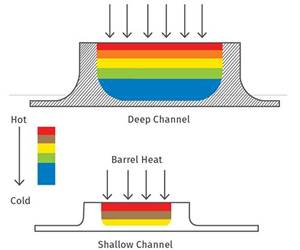Screw Design Is a Matter of Balance
Extrusion Know How
In order to achieve a balance between feeding, melting, and pumping it’s necessary to use proven calculations and/or tested empirical data in the design of each section.
Like most process systems, single-screw extruders need balance between their sections to be most effective. In order to achieve that balance between feeding, melting, and pumping it’s necessary to use proven calculations and/or tested empirical data in the design of each section. Simply varying a few dimensions in one section or another can lead to unintended consequences.
Pumping can be approximated by relatively simple drag-flow and pressure-flow equations as long as accurate viscosity data is available. Melting is much more complicated but can be approximated with reasonable accuracy by adjusting some of the basic equations developed in the 1960s by the researchers at Western Electric. However, these basic equations require a multitude of estimated data to satisfy the many different inputs required for a rigorous analysis. Some of this data is difficult and expensive to obtain, even in a laboratory environment, making it impractical and uneconomical for most screw designs. As a result, most melting-rate calculations contain a lot of empirical data to supplement the basic formulas in order to get a reasonably accurate analysis.
This includes information such as the initiation of melting, the pressure development at various axial barrel locations, the viscosity and temperature of the melted material, and information such as barrel wall thickness, placement of thermocouples, and barrel temperature at the inner wall. Melting-rate calculations also require complete polymer viscosity data at various temperatures, thermal conductivity and specific heat curves, power-law and consistency index, and heat of fusion.
I took a look at my own “simplified” melting-rate calculation and counted almost 100 pieces of data required to complete the analysis. That calculation couples the calculations for viscous heat generation in the polymer, the transport of the polymer, pressure development, and the thermodynamics of a scraped-wall heat exchanger.
For the feed section, the challenge is even greater. The data required is seldom published and is very difficult to obtain and apply to the basic volumetric calculation for feeding. Data such as the average particle size, packing, friction between polymer particles, friction between polymer particles and the screw and barrel, and temperature at the inner wall of the feed throat and barrel are required to even make a basic analysis. Consequently feeding analysis is almost entirely empirical, as much of this data is nearly impossible to obtain without extensive instrumentation and testing.
Unfortunately, the concept of “compression ratio” is often the only element used in the feeding analysis. That is a risky and inaccurate approach, as the compression ratio takes into account only the volume of the feed section vs. the pumping section. All other aspects affecting the feed rate are ignored. In addition the compression ratio usually affects the melting rate, potentially introducing some unintended consequences.
When these distinct functions of the screw are not in balance, a variety of negative performance issues can develop. One of the most common issues is instability or surging. Overfeeding can cause instability, high screw/barrel wear, high melt temperature, excessive power draw, and non-homogeneous melt. Underfeeding can cause instability, poor melting rate, and lowered output.
The same issues apply to the melting rate, as overfeeding can cause channel plugging and resultant instability, high screw wear, high motor load, and poor melt homogeneity. Conversely, underfeeding can cause poor melting rate and poor melt homogeneity.
Matching of the pumping section to the preceding sections is just as important. Under- or over-designing the pumping section affects output, melt temperature, melt stability, and melt homogeneity.
Each successive processing section depends on the output of the previous section. It’s unfortunate that the first section is the most difficult to predict, regardless of the sophistication of the calculations and computer analysis. Few designs are finalized on the first set of calculations, and at least one section usually has to be adjusted to achieve balance.
If mixing sections are involved, they add another section to match to the previous sections and incorporate a different set of calculations to determine the mixer’s effectiveness and transport.
In conclusion, a practice of altering a few individual dimensions without consideration of the balance required between the screw/barrel sections can lead to more problems than are solved. A single-screw extruder is a relatively simple mechanical device but when processing polymers from solid to melt, its behavior becomes more complex.
Related Content
Is a Gear Pump Right for Your Single-Screw Operation
As with everything else, there are pros and cons, but more of the former. They provide processors higher rates while decreasing the temperature of the extrudate while enabling downgauging.
Read MoreThe Importance of Barrel Heat and Melt Temperature
Barrel temperature may impact melting in the case of very small extruders running very slowly. Otherwise, melting is mainly the result of shear heating of the polymer.
Read MoreTroubleshooting Flow Surging in Single-Screw Extruders
Surging can cause lower production rates, higher scrap rates, material degradation and higher labor costs. Here is a guide to troubleshooting this problem.
Read MoreHow To Identify Resin Degradation in Single-Screw Extruders
Degradation can occur in many single-screw extrusion operations, and typically occurs due to minor design flaws in the screw. Here is how to track it down.
Read MoreRead Next
Making the Circular Economy a Reality
Driven by brand owner demands and new worldwide legislation, the entire supply chain is working toward the shift to circularity, with some evidence the circular economy has already begun.
Read MoreLead the Conversation, Change the Conversation
Coverage of single-use plastics can be both misleading and demoralizing. Here are 10 tips for changing the perception of the plastics industry at your company and in your community.
Read More.jpg;width=70;height=70;mode=crop)











